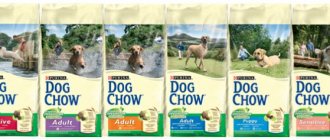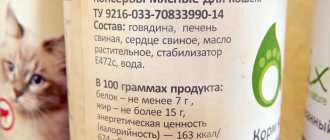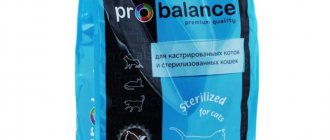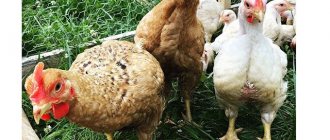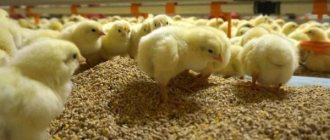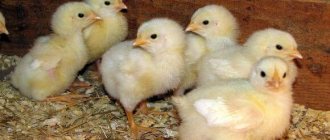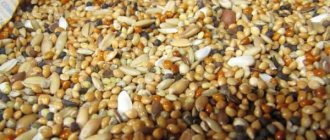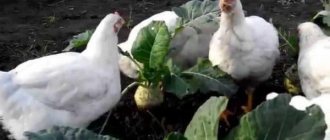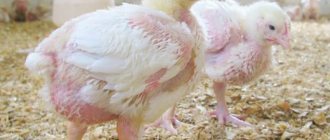The finishing mixture has a clearly balanced composition and provides the birds with everything they need, for this reason there is no need to resort to additional feeding.
The finishing mixture is the most expensive and complex in composition (in which the correct proportions are also important).
This feed includes:
- corn grains - 45%;
- wheat grains - 13%;
- sunflower meal or cake - 17%;
- meat and bone meal - 17%;
- feed chalk mixed with grass granules - 3%;
- yeast - 5%;
- feed fat - 3%.
At this stage of broiler growing, the constant availability of clean drinking water is especially important.
Feeding standards
We examined the composition of various types of feed. In addition to this indicator, you need to remember the quantity that the birds need, as well as the feeding regime of the flock.
As the body grows, the needs of the body change, although there are two main stages in terms of feeding: pre-launch (chickens) and fattening.
Chickens
Newly hatched chicks need to be fed often, but in small portions. Eight-time feeding is ideal; each chick is given no more than 50 grams of feed at a time.
The need for fats, proteins, carbohydrates and microelements is met by the following feed mixture:
- crushed corn, wheat and oats in equal quantities (in total 73% of the entire mixture);
- powdered milk;
- crushed soybeans or soy flour;
- remix for both chickens and remix for laying hens.
This composition is a pre-start feed and is given to young animals up to 8 days old. Try to distribute all meals evenly throughout the day, that is, approximately every 3 hours.
Fattening
Upon completion of the pre-launch stage, a longer stage begins - fattening the livestock.
During this time, the feeding regime of the livestock changes several times:
- from 7 to 14 days of life - six meals a day;
- from 14 to 28 - four times a day;
- from the moment of introduction of the finishing feed until slaughter - twice a day.
During the first period of fattening, the rate of giving food at a time is 50-90 grams per individual. Every 5-6 days this amount should be increased by 1.5-2 times.
Requirements for combined feed
Due to the fact that broilers are sent for slaughter at a fairly early age, poultry farmers need to pay maximum attention to their nutrition in the first two months of life. It is thanks to this that it will be possible to obtain high-quality meat products. Compound feeds intended for meat breeds of chickens are divided into several groups:
Compound feeds intended for meat breeds of chickens are divided into several groups:
- "Pre-start." The feed mixture is intended for chickens from birth to five days. The main task of these foods is to prepare the digestive organs for higher-calorie foods. All components are crushed as much as possible. The amount of useful substances in the composition increases in order to form a strong immune system.
- "Start". In this case, the maximum emphasis is placed on the development of bones and ligaments, but at the same time the caloric content of the diet also increases. This feed is used in feeding chickens starting from the fifth day of life.
- "Height". On the fifteenth day of life, the chicks begin to be given exactly this mixture. The composition becomes much richer and more varied. Calorie content also increases. The food itself is already larger.
- "Finish". This feed begins to be used when feeding broilers at one month of age. Due to the fact that during this period the birds gain the bulk of their weight, the mixture becomes as high in calories as possible.
Feed mixtures also differ in the size of the granules. Granules reach their maximum diameter only in finishing feeds.
No matter how balanced the food is, it cannot do without premixes. These are special supplements that contain minerals, amino acids, vitamins and medications. They may contain:
- vitamins A, K, C, E, D and the entire group B;
- iron, copper, zinc and a number of other minerals;
- enzymes that stimulate weight gain (amylosubtilin, protosubtilin);
- feed yeast;
- chalk needed to hold the ingredients together;
- tranquilizers and antibiotics.
Pellet and Grain Sizes
The effectiveness of feed depends not only on the composition, but also on the size.
Chicks should not be fed large granules or coarse grains: firstly, they will not be able to swallow them, and secondly, the bird will not be able to digest such coarse food. Depending on the age of the bird, the size of the food must vary.
Chicks in the first ten days of life can cope with microgranules, fine or finely ground cereals.
A chicken from 10 to 30 days can cope with 2 mm granules or medium-ground grain. A broiler from 30 days to slaughter is able to eat large granules up to 3.5 mm, coarsely or not at all ground grain.
The best option is to combine different nutritional methods if possible.
A method widely used in private and small farms: the mixture and mash alternate with each other. Dry mixture is always available in feeders, mash is added 2 times a day
DIY recipes
Self-production of feed mixtures allows you to reduce the cost of fattening livestock, especially if you use products available on the farm. The only equipment you need is a grain crusher.
There is also no chance of purchasing low-quality feed, because the production process and composition are regulated by the owner himself. Remember that during production it is necessary to calculate the amount of feed of each type per number of broilers.
"Pre-start and start"
The basis of the starter feed is corn. It accounts for almost half of the total volume and cannot be replaced (there are no cheaper or more accessible analogues of this crop).
Another 20% of the mixture is sunflower meal and cake; they can be replaced with the same processing products of any oilseed crop (rapeseed, flax). Of the grains that are most suitable for chickens, wheat or oats account for 17-19% of all feed.
Herbal flour or dry skim milk is mixed in as a vitamin supplement. You should also add some feed or fish oil, as well as a good shelf life vitamin premix.
Growth compound feed at home is prepared (cooking) from:
- corn grains;
- oats or wheat;
- barley;
- meat and bone meal;
- herbal granules;
- growth yeast;
- feed fat (no more than 2%);
- dry skim milk
After crushing, dilute the mixture with water to a thick mushy mass, which is passed through a meat grinder. You will get convenient storage granules, just let them dry thoroughly. Eggs or dairy products are mixed in right before serving.
You can add table salt, feed chalk, protein and vitamin concentrates to the composition - all no more than 3%.
In the summer, greens from your plot will be an excellent addition; chickens do not disdain weeds. You can also periodically feed millet, rice grains and waste from vegetable processing.
"Height"
Preparing food takes place in several steps:
- Step 1. Grind 11.250 gr. corn (45%), 2.5 kg of wheat (10%), 3.750 grams of corn (15%), 2.5 kg of soybeans (10%).
- Step 2. Add 1.25 kg. yeast (5%), 1.750 kg. fish meal (7%), 300 grams of chalk (1-1.2%), 1 kg. meat and bone meal (4%), shells (0.3 grams per day per head), herbal meal (optional).
"Finish"
This type of feed should be prepared the most, since it is required for the longest stage of fattening.
The final diet includes:
- corn grains;
- any legumes (peas, beans, soybeans);
- wheat, oats or barley;
- feed yeast;
- feed fat;
- chalk or limestone;
- protein-vitamin concentrate (here it accounts for up to 12% of the total mass).
The granules should be made as large as possible to increase the period of food consumption, digestion and the percentage of well-stabilized nutrients.
How to cook it yourself
Let's see how to make inexpensive, high-quality food with your own hands. The optimal amount is easy to calculate - multiply the number of birds by 25. In the first couple of weeks of life, chickens eat 25 g per day, but with age, the need for nutrition increases. In the period before slaughter, the broiler eats 150 g of feed per day.
The main components of the homemade mixture are cake with corn. As a source of protein, take meal (bone meal, fish meal), and for protein - ground grass. Broilers also love alfalfa.
Starter kit proportions:
- 4.8 corn (can be replaced with flour);
- 1.9 sunflower cake or meal;
- 1.3 wheat (including ground);
- 0.7 bone meal;
- 0.5 yeast (press);
- 0.3 herbal flour;
- 0.1 fat.
The finish is more caloric and nutritious. To prepare, take:
- 4.5 parts corn flour;
- 1.7 sunflower cake (analogue - meal);
- 1.7 bone protein meal;
- 1.3 parts wheat (fraction);
- herbal flour with chalk - 0.1 parts each;
- 0.5 yeast;
- 0.3 feed fats.
Balanced feed for broilers is easy to make yourself, but you will have to figure it out and spend time. The main advantages are the correct composition, high-quality ingredients, low price.
Useful tips
Along with proper feeding, it is necessary to timely vaccinate birds against diseases using antibiotics, and also periodically add potassium permanganate to drinking water, which will prevent stomach upsets and improve the microflora of the digestive system.
It is necessary to carefully prepare the pen upon settlement. The floors and walls of the room should be covered with whitewash, which will reduce the likelihood of epidemics and diseases of the bird.
It is recommended to clean the room daily of waste products and carefully ensure that they do not get into food or drink.
No less dangerous for livestock can be the presence of moisture on the floor or walls. In a poultry pen, any damp surface will be an ideal environment for the development of bacteria, which can lead not only to digestive disorders, but also to infections leading to death.
It is recommended to monitor the humidity in the room and establish minimal ventilation. With high or low humidity, the activity of animals decreases, anomalies in development and losses in livestock begin.
Without ventilation, ammonia and other associated gases can threaten the safety of broilers.
Access to feeders and drinkers should not be difficult, and there should be no crowding in the pen. It is worth paying attention to hygiene: drinkers and feeders should be higher than floor level, chickens should not walk or defecate in feeding areas.
Review of feed for broilers
Although there are many different brands, there are a few that are most well known. It is worth considering them in more detail so that the farmer can determine which one is most suitable for his broilers.
Feedlife
He is considered one of the best. Agronomists gave it high praise, since its composition can increase the immunity of broilers, improve their genetic characteristics and enhance the taste of meat. Corn from 50% to 69%, depending on the type of feed.
Thus, there is really a lot of protein in food. However, there is relatively little fiber - 4%.
You can find many positive reviews on the Internet. Farmers note the low price and high-quality mixture.
Kalinka
The food is produced in the Netherlands, which guarantees European quality. The mixture contains no hormonal additives or artificial growth stimulants. At the same time, broilers grow really quickly without their additional use. Sold only in granular form.
The company currently markets 4 types of food:
- Prestarter Kalinka PC 2400.
- Kalinka Starter PC 5-1.
- Grover PC 5-4.
- Finish PC 6-4.
Thus, this manufacturer provides farmers with the necessary products at any time in the life of broiler chickens.
Rozovka
A popular brand that has already established itself. The mixtures are of high quality and prices are reasonable. Many entrepreneurs note rapid weight gain and relatively low feed consumption.
Purina
Many farmers prefer to use feed from this manufacturer, since it has been operating in Russia for a long time and offers high-quality products.
Here are the main advantages of this feed:
- the ability to raise broilers up to 3 kg;
- does not have a negative impact on the quality of meat and eggs;
- increases chicken immunity;
- improves plumage.
All this can be achieved by adding vitamins and minerals to the concentrate that chickens require for normal development.
Sumi and Astarte
These two brands are also famous among farmers. They are inexpensive and give chickens everything they need to grow quickly. However, due to the large amount of protein food, additional vitamins must be given.
It is worth noting that it is normal to give additional vitamin complexes to broilers.
They quickly gain weight, and therefore the body does not have time to adapt to new conditions. In order not to slow down the rate of weight gain, it is necessary to provide broilers with the necessary minerals and other additives.
Nutrition at one month of age
1.5 months after birth, the chickens’ diet is supplemented with corn and dry grain. For older broilers, you can prepare your own feed. Below are the nutritional features of chickens older than 1 month.
- Broilers can be fed mixed grain. For example, peas can be combined with crushed wheat and barley grains. The mixture should include a mineral supplement or a mineral-containing premix.
- To improve the taste characteristics of meat and speed up the process of gaining fat mass, you should sprinkle corn on the chicks every day.
- It is systematically necessary to provide wet mash to broilers. In this case, the proportions of grain feed are set by the breeder himself.
- Fish oil included in the diet will become a source of vitamins and fatty acids.
By choosing the right food and providing the bird with timely nutrition, you can expect that by the age of 70 days the little chicken will have gained up to 4 kg.
conclusions
- Combined feed mixtures allow you to obtain the largest amount of meat, for this reason they are in great demand among broiler poultry farms.
- Compound feeds are divided into three main types: starting (start), growth and finishing (finish), depending on the period of feeding to the livestock.
- Different types of feed differ from each other in composition and feeding regime for birds.
- You can prepare such bird food yourself, with your own hands according to the table, instructions, and calculations; this will help you save on the purchase of factory-made products.
Recipe
Do-it-yourself preparation of feed for broilers takes place in the percentage of grain and special feed additives
At each stage, it is important to include fish or meat and bone meal in the feed, which provide saturation with animal protein, important for optimal growth and development of muscle tissue. Homemade feed is distinguished by the quality and naturalness of the products
The percentage of components is established by state standards.
Until the 14th day from the moment the chicks hatch, a mixture consisting of:
- 50% corn flour;
- 16% milled wheat;
- 14% crown;
- 12% low-fat kefir;
- 8% barley.
The grain must be ground into flour, since babies cannot eat the whole product. First, mix dry foods, then add kefir or cottage cheese in portions for each feeding. Only dry food can be stored.
From the 15th day, birds are transferred to food, which consists of:
- 48% corn flour;
- 19% sunflower cake;
- 13% milled wheat;
- 7% fish or meat meal;
- 5% feed yeast;
- 3% herbal flour;
- 2% feed fats.
The grind of the feed should be a little coarser than in the previous recipe, since at this time the chickens are already beginning to learn to peck coarser food.
